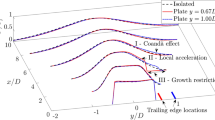Abstract
Measurements of mean velocity components, mean flow direction, turbulent intensities and Reynolds shear stress were made with a split film probe of hot wire anemometer to investigate the flow field generated by two identical jets of air issuing from plane parallel nozzles in a common end wall and mixing with the ambient room air. Due to the sensitivity of the split film probe to the flow direction, the reverse flow in the converging region was detected by the split film probe and observed by flow visualization. The mean velocity approaches self-preservation in both the converging and the combined regions, while the turbulent intensities and Reynolds shear stress approach self-preservation in the combined region only. The trajectory of the maximum velocity is almost unchanged by variance of nozzle spacing in the converging region. The distance of the merging point from the nozzle exit increases linearly with nozzle spacing. The spread of the converging jet increases more rapidly than that of the combined jet.
Similar content being viewed by others
Abbreviations
- D :
-
nozzle width
- O :
-
origin of the coordinates
- S :
-
nozzle spacing
- U, V, W :
-
mean velocities
- U 0 :
-
axial velocity at nozzle exit
- u, v, w :
-
velocity fluctuations in the X, Y, Z axis respectively
- u′, v′, w′ :
-
rms of u, v, w
- \(\overline {uv} \) :
-
Reynolds shear stress
- X, Y :
-
Cartesian coordinate
- Y * :
-
ordinate in the Y-axis start at maximum axial velocity of jet in each measured section
- Xm, Ym :
-
ordinates at maximum axial velocity of jet in each measured section
- Y 0.5 :
-
distance from the location of maximum axial velocity to the location where the velocity is half of maximum axial velocity in each measured section
- η :
-
=Y/S
- c.p. :
-
combining point
- max:
-
maximum value
- mp :
-
merging point
- o :
-
nozzle exit plane
- v.c. :
-
vortex center
References
Gutmark, E.; Wygnaski, I. 1976: The planar turbulent jets. J. Fluid Mech. 73, 465–495
Krothapalli, A.; Baganoff, D.; Karamcheti, K. 1981: On the mixing of a rectangular jet. J. Fluid Mech. 107, 201–220
Lin, Y. F. 1989: Interaction of two plane parallel dual-jet flows. Ph.D. Thesis, Dept. of Power Mech. Eng., National Tsing Hua University Taiwan
Miller, D. R.; Comings, E. W. 1960: Force momentum fields in a dual-jet flow. J. Fluid Mech. 7, 237–256
Tanaka, E. 1970: The interference of two-dimensional parallel jets. Bull. JSME, 13, 272–280
Tanaka, E. 1974: The interference of two-dimensional parallel jets. Bull JSME, 17, 920–927
Author information
Authors and Affiliations
Rights and permissions
About this article
Cite this article
Lin, Y.F., Sheu, M.J. Investigation of two plane paralleltiinven ilated jets. Experiments in Fluids 10, 17–22 (1990). https://doi.org/10.1007/BF00187867
Received:
Issue Date:
DOI: https://doi.org/10.1007/BF00187867




